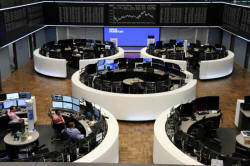Stocks marginally higher as gold, oil declines spook sentiment
 Send a link to a friend
Send a link to a friend
 [August 09, 2021] By
Ritvik Carvalho and Wayne Cole [August 09, 2021] By
Ritvik Carvalho and Wayne Cole
LONDON (Reuters) - Global shares made tentative gains on Monday as sharp
falls in gold and oil prices briefly spooked sentiment, while the dollar
reached a four-month high versus the euro after an upbeat U.S. jobs
report lifted bond yields.
European shares ticked slightly higher after a mixed start in early
trading, as a fall in commodity prices weighed on Britain's blue-chip
index, while other regional indexes stayed near recent highs with
earnings season winding down. [.EU]
The pan-European STOXX 600 index rose 0.06% by 1135 GMT, after having
spent most of the morning in negative territory. Britain's FTSE 100
index dipped 0.3% and Germany's DAX 30 edged 0.1% lower.
MSCI's All Country World Index, which tracks shares across 49 countries,
was marginally higher, up 0.06% on the day.
Nasdaq futures slipped 0.1% and S&P 500 futures 0.2%.
Markets were shaken early by a sudden dive in gold, as a break of $1,750
triggered stop-loss sales to take it as low as $1,684 an ounce. It was
last down 1% at $1,745.

Brent also sank 2% on concerns the spread of the Delta variant of the
coronavirus could temper travel demand.
Holidays in Tokyo and Singapore made for thin trading conditions, adding
to the volatility. Yet after an initial fall, MSCI's broadest index of
Asia-Pacific shares outside Japan recovered to be up 0.1%.
They were helped by China's blue-chip index which added 1.3%. Japan's
Nikkei was shut but futures were trading a modest 20 points below
Friday's close.
Chinese trade data out over the weekend undershot forecasts, while
figures out Monday showed inflation slowed to 1% in July, offering no
barrier to more policy stimulus.
The U.S. Senate came closer to passing a $1 trillion infrastructure
package, though it still has to go through the House.
Investors were still assessing whether Friday's strong U.S. payrolls
report would take the Federal Reserve a step nearer to winding back its
stimulus.
"What we're seeing is a little bit of early profit-taking on the back of
fear that tapering will come in earlier in September," said Sebastien
Galy, senior macro strategist at Nordea Asset Management. "But as you
can see, it has little impact because the effect of a better economy far
outweighs the substitution effect of higher interest rates."
LONGER TAPER
However, the pace of tapering was still up in the air and would decide
when an actual rate increase comes, he said. The Fed is buying $120
billion of assets a month, so a $20 billion taper would end the
programme in six months while a $10 billion tapering approach would take
a year.
[to top of second column] |

The German share price index DAX graph is pictured at the stock
exchange in Frankfurt, Germany August 6, 2021. REUTERS/Staff/File
photo

The spread of the Delta variant could argue for a longer taper, with U.S. cases
back to levels seen in last winter's surge with more than 66,000 people
hospitalised.
Figures for July CPI due this week are also expected to confirm inflation has
peaked, with prices for second-hand vehicles finally easing back after huge
gains.
Four Fed officials are speaking this week who will no doubt offer enough grist
for markets looking for clues on the timing of tapering.
In the meantime, stocks have been mostly underpinned by a robust U.S. earnings
season. BofA analysts noted S&P 500 companies were tracking a 15% beat on
second-quarter earnings with 90% having reported.
"However, companies with earnings beats have seen muted reactions on their stock
price the day following earnings releases, and misses have been penalized," they
wrote in a note.
"Guidance is stronger than average but consensus estimates for two-year growth
suggest a slowdown amid macro concerns."
Financials firmed on Friday as a steeper yield curve is seen benefiting bank
earnings, while also penalising the tech sector where valuations are sky high.
Yields on U.S. 10-year notes were up at 1.28% in the wake of the jobs report,
having last week hit their lowest since February at 1.177%.
That jump gave the dollar a broad lift and knocked the euro back to $1.1760, and
briefly to its lowest since April at $1.1740. The dollar likewise climbed to
110.22 yen and away from last week's trough of 108.71.
That took the U.S. currency index up to 92.922 and nearer to the July peak of
93.194.
Oil prices eased further after suffering their largest weekly drop in four
months amid worries coronavirus travel restrictions will threaten bullish
expectations for demand. [O/R]

Brent fell 3.7% to $68.09 a barrel, while U.S. crude lost 3.8% to $65.66.
(Reporting by Ritvik Carvalho; Additional reporting by Wayne Cole in Sydney;
Editing by Robert Birsel and David Holmes)
[© 2021 Thomson Reuters. All rights
reserved.] Copyright 2021 Reuters. All rights reserved. This material may not be published,
broadcast, rewritten or redistributed.
Thompson Reuters is solely responsible for this content. |